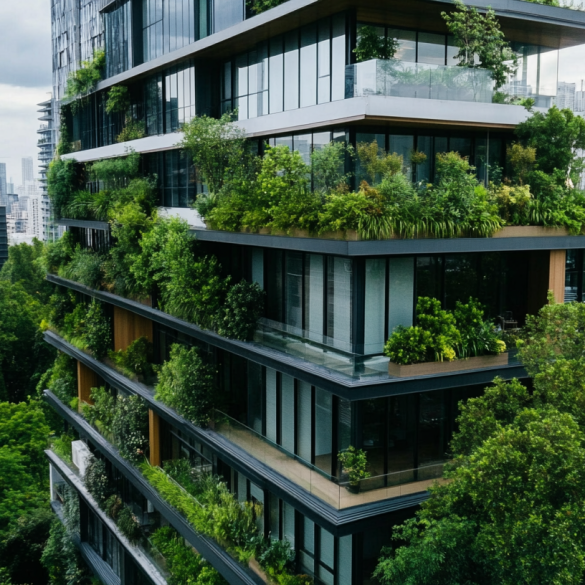Ever thought about turning smal urban spots green? Vertical gardens are all the rage, especially for those tight on space. You can grow a wide range of plants up a wall. This uses every inch of your space wisely. For example, plants like radishes and green onions do well in pots that are 6 to 9 inches deep. This makes them perfect for going vertical1.
Products like Wallgarden can hold a lot of water, from 4.7 to 5.3 liters. They work great for all kinds of plants, big or small. These products help roots grow strong and keep water well thanks to how they’re built. Keri Algar, an expert from Sustainable Home Magazine, suggests using special soil mixes. Mix in things like organic matter and Coir peat, vermiculite, or perlite. They boost your plants’ health and growth.
For the best setup, you’ll want to think about what each plant needs. That includes how much light, what kind of soil, and how often to water them.
Key Takeaways
- Vertical gardening optimizes small spaces, perfect for cities.
- Wallgarden products are great for all sorts of plants, with their big capacity and smart design.
- Plants like radishes and green onions do best in shallow pots, which is ideal for going vertical.
- The right soil mixes make plants grow better in vertical gardens.
- Design your vertical garden to fit the needs of the plants, like how much sunlight or nutrients they need.
Understanding Vertical Gardens and Their Benefits
Vertical gardens are a new and smart way to grow plants. They are great for places with not much ground space, especially in cities.
What is a Vertical Garden?
A vertical garden is like a wall full of plants. It can be small or large. People have been growing plants this way for a long time. You can use hydroponics, which means growing plants without soil, or just regular soil.
Cities are starting to use these gardens more and more. They are good for the environment. Plants like ferns, ivy, and ferns do really well in these gardens.
Benefits of Vertical Gardens
Vertical gardens offer many good things. They let gardeners use more space, which means they can grow more food2. They also make farming easier on the body, since you don’t have to bend over all the time2. This lowers the chance of getting sick because plants are not on the ground as much and get more fresh air2.
Using a vertical garden can be pretty, give you some privacy, and clean the air3. It’s a great way to use a small area.
Plants get more sun in vertical gardens. This means they grow better2. Most vegetables need a lot of sunlight to grow well. How they are positioned affects how they grow.
Vertical gardens help stop soil from washing away when it rains, which is good for the ground4.

Popular Vertical Gardening Methods
There are different ways to make a vertical garden outside. You can use things like trellises, arches, and wire cages for plants to climb2. You can also use pots and baskets for smaller plants.
Inside, you can use shelves and wall planters for your garden4. Special lights are used to help the plants grow indoors.
When picking plants for your garden, think about the weather in your area3. Choosing the right plants is very important.
There are many do-it-yourself ideas for making a vertical garden. You can use old pallets or make your structures2. You can grow flowers or food, whatever you like.
Make your garden beautiful by mixing different plants. Giving them plenty of water and sunlight is key to a successful garden3.
Best Edible Plants for Vertical Gardens
Picking the right plants for your vertical garden is key for both looks and yield. You have many choices to grow a range of tasty crops in a small area. We’ll look at the best picks by how deep their roots go.
Shallow Rooted Edible Plants
If your vertical garden has little soil depth, go for plants with shallow roots. Herbs like basil and mint work great and can be in hanging pots or stacked planters. They make the most of small soil spaces5. Also, try radishes, lettuce, and spinach. They do well with 6 to 9 inches of soil.
Plants with Moderate Root Depth
Some crops need a bit more room for their roots, like peppers and peas. Peas are climbers and add taste to your garden. Beans come in many colors and are fun to grow too5. Make sure they have containers with 12 to 18 inches of soil.
Deeply Rooted Edibles
For the big veggies, you need deep planters, like those 18 to 24 inches deep. Tomatoes are a favorite for vertical gardens. They grow tall with the right support5. Cucumbers also do great vertically, saving ground space. Zucchini and beans love to climb. They do best with lots of soil and space to grow up.
Below is a table that shows the best plants based on root depth for vertical gardens:
| Root Depth | Plants | Special Requirements |
|---|---|---|
| 6-9 inches | Herbs (basil, mint, thyme), Lettuce, Spinach, Radishes | Hanging pots, stacked planters |
| 12-18 inches | Peppers, Peas, Broccoli | Tall trellises, pocket gardens |
| 18-24 inches | Tomatoes, Cucumbers, Beans, Zucchini | Sturdy support systems, deep planters |
Choosing plants based on their root depth is smart for a great harvest in your vertical garden6. It not only saves space but also helps plants be healthier. They get more air and sunlight this way5.
Optimal Ornamental Plant Types for Vertical Gardens
Ornamental plants make your vertical garden look great. To get the best look, choose plants that fit the garden’s light and space needs.
Choosing Plants Based on Light Requirements
Choosing plants for your garden depends on how much light they need. For inside, Golden Pothos and ferns are great. They like light from low to bright, but not direct7. Outside, you might like spring plants such as pansies and alyssum. They do well in cooler weather. For summer, petunias and begonias are good choices7.
Ideal Trailing and Climbing Ornamentals
Trailing and climbing plants are perfect for your garden. Devil’s Ivy is a favorite, needing little attention when in hanging pots8. Lipstick plants are beautiful and easy to care for. Staghorns do well indoors with some humidity and light shade8.
Indoor vs Outdoor Options
Deciding on plants is different for indoor and outdoor spaces. Urban backyards might use green walls. These walls can support themselves8. For inside, try Zanzibar Gem, which doesn’t need much water. The Monstera is popular but needs regular trimming8. Pallet planters or hanging baskets also help choose the right plants8.

Both indoor and outdoor gardens give chances to plant in special ways. By picking plants smartly, you can have a beautiful and thriving garden. Think about light, climbing plants, and where the garden is to make it just right.
Plant Types for Vertical Gardens: Care and Maintenance
Maintaining a vertical garden means you must care for the specific plants. You need the right soil, correct watering, and good pest control. These steps are crucial for a healthy garden.
Soil and Nutrient Needs
Choosing the best potting mix is vital for your plants. For example, Wallgarden pots should have 5.3 liters of potting mix per plant. They also have holes at the bottom for air9. The mix should have things like bark, sawdust, and CoCo Peat, with sizes from 0-12mm9. Adding mature compost from cow manure, chicken manure, and worms helps a lot9. Coir peat and perlite or vermiculite help with water and air9. These ingredients are key for your garden’s success.
Watering Techniques
Watering your garden right is important. Too much water can cause root rot, but not enough makes plants dry up. Succulents need very little water, which makes them perfect for vertical gardens10. Drip irrigation systems keep the moisture steady, which plants like basil, mint, and parsley love10.
Pest Control Strategies
Keeping pests under control is crucial too. Integrated pest management (IPM) is the best approach. It uses different methods to keep pests away, like planting basil and mint as natural repellents10. Plants like the wax flower (Hoya carnosa) not only clean the air but also help keep your garden free from bad pests9. Following these steps helps your garden grow well. It also attracts beneficial insects, which is good for the city’s natural life10.
Conclusion
Vertical gardening changes how we use space and makes cities greener. It helps more plants grow even in small areas. This happens in places where many people live, making the air cleaner and adding homes for wildlife11. The right plants, like vines and succulents, make sure your garden thrives and gets enough light and water11.
More and more, people are adding vertical gardens in towns, with a 35% rise recently12. This trend shows no sign of stopping. People like to use succulents and ferns because they don’t need a lot of water and look nice. They also grow herbs and tomatoes for fresh food13. If you use smart watering and take care of your plants properly, they’ll be healthier11. This helps you pick the best plants for your garden by knowing what they need.
When you explore different vertical garden designs, you can choose plants that fit your weather and save water12. This makes green spaces around homes and in businesses more lasting. Watching for bugs and pruning your plants well keeps your garden beautiful. These methods can make any space look better and help our planet. They go well with the look of modern cities, too. For more about how vertical gardens can change your space, see the ultimate guide to vertical gardens.









1 comment
[…] and shrubs to let sunlight in. Harvest plants carefully to keep them from getting too big. Use vertical gardens to save […]